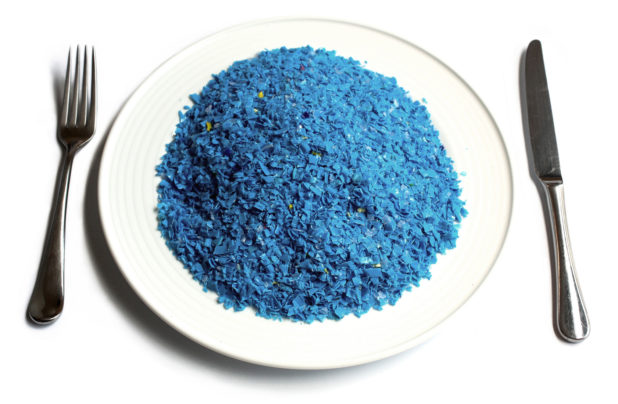Pictured: the amount of plastic a person eats in a year, according to a WWF study.
The Guardian has published an environmental investigation about microplastics that paints a grim picture: there is no escape. Plastic is everywhere. It’s even inside of you right now.
As much as the idea might be unpalatable, all of our diets are now likely to include tiny servings of plastic.
The places where microplastics and plastic fibres have been found is beginning to read like a supermarket shopping list.
Studies have found microplastics – that is, pieces or fibres smaller than 5mm – in foods including tea, salt, seaweed, milk, seafood, honey, sugar, beer, vegetables and soft drinks. Tap water contains plastic. Bottled water contains even more.
Across our terrestrial and marine environments, microplastics have been found in most places where scientists have looked, including some of the most remote spots on Earth, threatening and, in some cases killing, wildlife.
But when it comes to the effect of omnipresent plastic on human health, what’s the risk?
“Nobody really knows the answer,” says Prof Mark Taylor of Macquarie University in Sydney and an expert on environmental contamination. “But the absence of evidence is not evidence of absence.”
…
This week, a study of rice bought from supermarkets and a bulk-food store in Queensland became the latest to deliver a warning.
Researchers found plastic in every sample, whether the rice was grown in Thailand, India, Pakistan or Australia and whether the rice was packaged in plastic or paper.
Washing the rice reduced the amount of plastic likely to be ingested. But the study used special filtered water for rinsing. Most households only have access to tap water (which contains microplastics).
Precooked rice – the kind that comes in microwaveable sachets – had the most plastic. But the amounts are tiny.
The study says a 100g serve of rice typically contains 3.7mg of microplastics if it’s unwashed, 2.8mg if it’s washed or 13.3mg for instant rice (in the microwaveable pouches). A single grain of rice weighs roughly 30mg.
Dr Jake O’Brien, a lead author of the study from the Queensland Alliance for Environmental Health Sciences, says the higher levels of plastic in precooked samples was more likely down to the extra processing it goes through before it’s packaged, rather than the plastic packaging itself.
According to the study, there are multiple opportunities for rice to pick up plastics, from the soils to the machines used to pick, store, move and process the rice, to the packaging and handling.
…
Our exposure to tiny pieces of plastic isn’t limited to what we drink or eat. A team from Macquarie University in Sydney took samples of airborne dust from homes and in a study released earlier this month found about 40% of it was plastic.
Microplastic is clearly making its way into our bodies because it has been found in human poo.
Scientists in Italy developed a plastic-free protocol in a hospital delivery room, and then examined placentas. They found microplastics there too.
Why on earth did we make all of this plastic?

